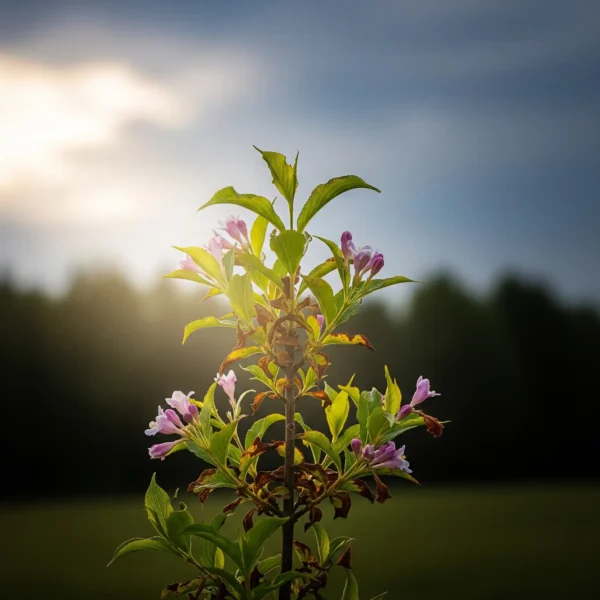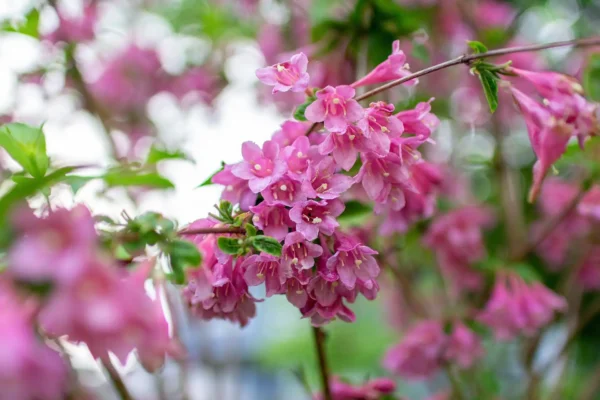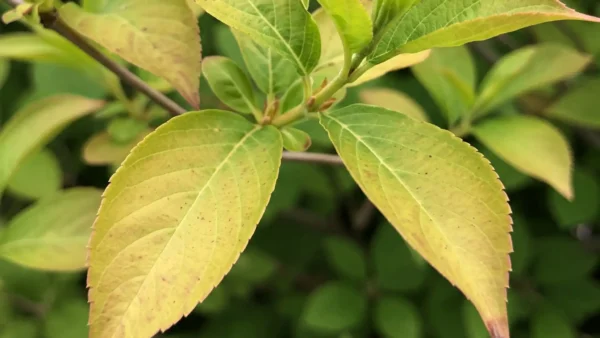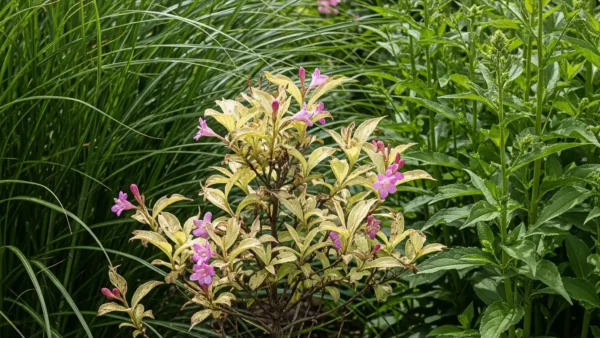Soil pH is important. Why Your Weigela Dislikes Alkaline Conditions (and Displays it with Yellow Leaves!)
A true showpiece in your yard, your Weigela should be a sight of lush green leaves and colorful, trumpet-shaped flowers. But are you noticing sad, yellowing leaves, a general lack of vitality, or a poor flower display despite your best efforts with watering and fertilizing? It can be really annoying! Its pH level could be the hidden offender just waiting in your soil.
For gardeners, this is typical: you believe you are doing all the correct things but your plant is obviously suffering. Though many of us don’t instantly think of soil chemistry, an inappropriate soil pH—especially soil that is overly alkaline (meaning it has a high pH)—can greatly affect the health of your Weigela. From a shrub that ought to be a star, this might result in quite obvious symptoms including that dreaded chlorosis (yellowing leaves) and general subpar performance.
But don’t worry; this article will clarify soil pH. We’ll tell you precisely why alkaline conditions are harmful for your Weigela, help you identify the important warning signs, and offer reasonable, down-to-earth advice for testing and changing your soil. We want to assist you in building a happier, healthier house where your Weigela may really flourish.
Revealing Soil Secrets: Exactly What Is Soil pH?
Let’s briefly discuss what soil pH really is before we delve into the nitty-gritty of how alkaline soil influences your Weigela. Though it may seem a little technical, the fundamental idea is really straightforward.
A Basic Chemistry Class: Grasping the pH Scale
The pH scale measures how alkaline or acidic a chemical is. Running from 0 to 14,
- A pH below 7 is regarded as acidic.
- Seven on the pH scale is neutral.
- A pH over 7 is considered alkaline; occasionally it is called “basic” or “sweet” soil.
Imagine it as a scale for the personality of your soil; is it leaning toward sourness (acidic) or sweetness (alkaline)? Most garden plants have a specific pH range in which they thrive.
Why Should Plants Care About Soil pH? The Link of Nutrients
This is the vital component! Soil pH influences directly the availability of necessary nutrients in the soil. It’s similar to a gatekeeper. At certain pH levels, several nutrients become more or less soluble, thereby determining their availability for plant roots to absorb.
A particular plant may find certain essential nutrients “locked up” in the soil if the pH is too high (alkaline) or too low (acidic). This indicates that the plant cannot really reach those nutrients even if they are physically in the soil. It’s like having a locked fridge full of food!
Weigela’s Ideal Habitat: Key is Slightly Acidic to Neutral
So, where is the sweet spot for our cherished Weigelas? Slightly acidic to neutral soil usually suits them best. Though they can usually endure situations up to about pH 7.5 without too much problem, often a pH range of roughly 5.5 to 7.0 is perfect.
They usually don’t do well, though, on clearly alkaline soils—that is, soils with a pH well over 7.5. Here is when the issues really begin to appear.
The Alkaline Agony: How High pH Affects Your Weigela
A Weigela in soil too “sweet” or alkaline may experience many issues mostly connected to obtaining the food it requires.
Nutrient Lockout: The Main Culprit—Starvation Amidst Plenty
In alkaline soil, nutrient lockout is the main problem for Weigelas (and many other plants that like somewhat acidic conditions).
Concentrate on iron chlorosis since it is the most prevalent and obvious issue. High pH soils—usually over 7.0-7.5—make iron far less soluble. Though there is lots of iron physically present in the soil, this indicates it is chemically “tied up” in the soil and your Weigela’s roots cannot absorb enough of it.
The Result: The creation of chlorophyll—the green pigment in leaves enabling plants to photosynthesize—requires iron totally. Insufficient iron prevents the plant from generating sufficient chlorophyll, hence causing the typical yellowing of the leaves—a condition called iron chlorosis.
Other Affected Micronutrients: It’s not only iron. Alkaline soil conditions can also greatly limit the availability of other vital micronutrients such manganese, zinc, and copper, hence stressing the plant even more.
Beyond Nutrient Lockout: Alkaline Soil’s Other Negative Effects
Although nutrient lockout is the main issue, very alkaline soil can also harm other ways:
Sometimes Poor Soil Structure: Occasionally, excessively high pH levels can be linked to sodic soils, which usually have a bad, compacted structure. Roots find it difficult to penetrate and water and air have trouble moving through the soil. For most garden circumstances, however, the nutrient lockout is the more urgent concern for Weigelas.
The health and variety of the soil microbiome—all those little bacteria, fungus, and other creatures living in the soil—is greatly influenced by soil pH. Extreme pH levels—either too acidic or too alkaline—can suppress the activities of beneficial microorganisms supporting nutrient cycling, organic matter decomposition, and general plant health.
Reading the Distress Signals: Signs of Alkaline Soil Stress in Weigela
Your Weigela will attempt to inform you when its soil pH is incorrect. Learning to identify these distress cues is essential:
The Classic Telltale Sign: Yellowing Leaves (Chlorosis)
The classic symptom of iron deficit brought on by alkaline soil is this.
Thorough Description:
Often, the yellowing begins on the newest growth—the younger leaves at the branch tips. Iron is an immobile nutrient in the plant, hence the plant cannot readily transfer it from older leaves to new ones. New leaves therefore reveal the deficit first.
Typically, the leaves go from a pale green to a clear yellow, while the leaf veins usually stay green. A highly strong diagnostic indicator for iron deficit, this pattern is known as interveinal chlorosis.
In extreme or protracted situations, the whole leaf—including the veins—may go yellow and then nearly white before finally forming brown, dead areas and dropping off.
Weak or Stunted Growth: Symptom #2
A Weigela without necessary nutrients will not develop as well overall.
You may find that the shrub’s general growth is lacking. The plant may just not grow to its anticipated size or show its normal vitality; new branches could be short and spindly. It could simply seem “puny” or “unhappy.”
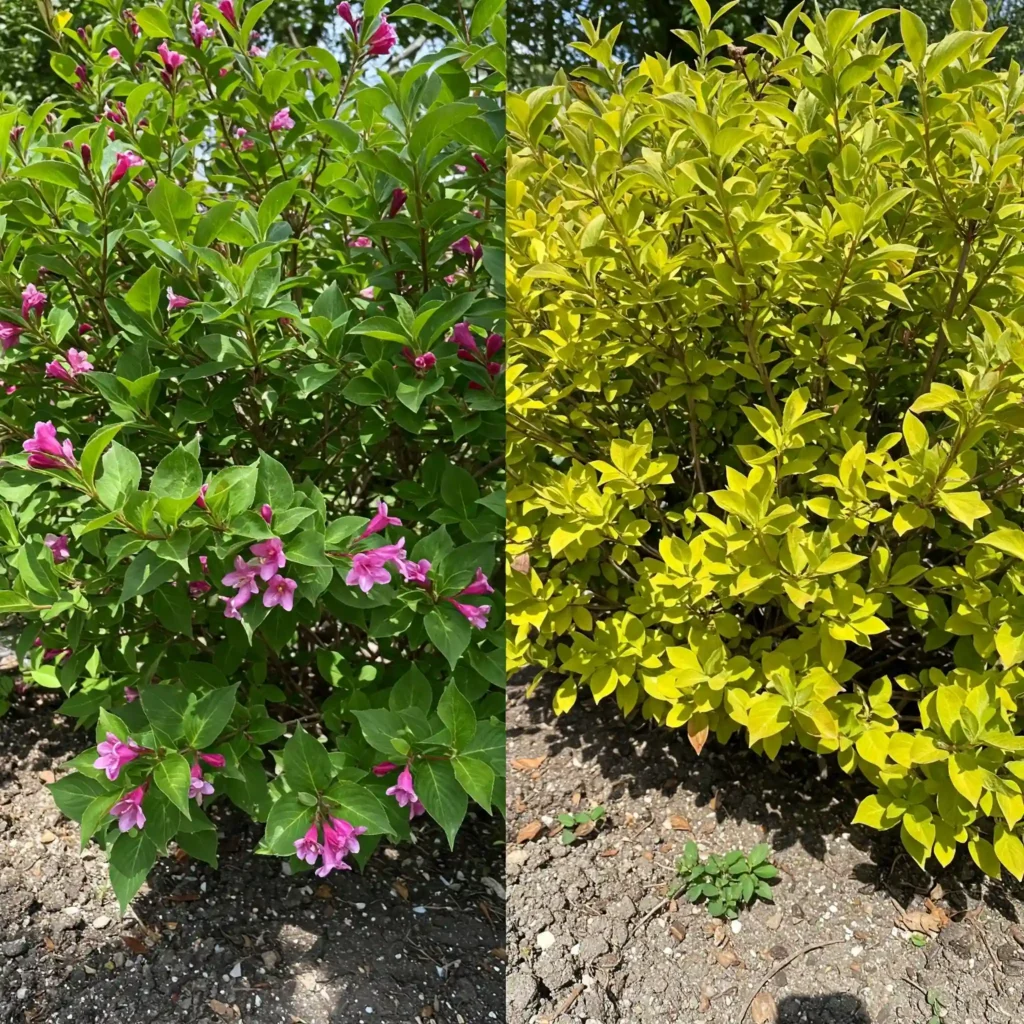
Nutrient shortages and the constant strain of surviving in inappropriate soil conditions block good cell division, elongation, and general development.
Decreased or Bad Quality Flowering
A strained Weigela lacks the vitality to display a stunning flower show.
The plant could generate less than usual flowers, or the ones that do show might be smaller or less colorful. In extreme situations of nutrient deficit caused by high pH, flowering could stop completely or buds could develop but not open correctly.
The reason is that producing flowers uses a lot of energy. The plant will definitely not have the extra resources required for strong flowering if it is fighting to obtain fundamental nutrients for healthy leaf growth.
Symptoms #4: Premature Leaf Drop, Brown Edges, or Leaf Scorch
The leaf problems may get worse as the stress from alkaline soil conditions persists.
Description: In more advanced stages, the yellowed, chlorotic leaves may have brown, scorched-looking margins or dead spots. Even long before autumn, the plant may also begin to lose these damaged leaves early.
Severely nutrient-deficient leaves are fragile, less able to withstand external pressures like sun or wind, and more prone to injury and eventual abscission (falling off).
Playing Soil Detective: How to Identify High Soil pH
Although the following symptoms are clear signs, testing your soil is the only method to determine whether it is too high. Don’t just assume!
A Soil Test’s Significance
While a soil test gives a clear pH result, visual indicators can guide you in the correct way. It is the basis for deciding about soil amendments wisely and removes the uncertainty from the equation.
Choices for Soil Testing:
Your soil pH testing choices are twofold:
DIY Home Soil Testing Kits:
- These kits are rather cheap and easily found at most garden centers. Often in minutes or hours, they can offer a fast estimate of your soil pH.
- Disadvantages: They may be less accurate than professional laboratory tests and usually only provide a pH range (e.g., “slightly alkaline”) instead of a precise number.
- Usually, you combine a soil sample with a kit-supplied solution and then match the color of the solution to a chart. Always adhere to the particular directions included with your selected package.
Professional Laboratory Soil Tests:
- Advantages: This is the most thorough and precise alternative. Often including a treasure trove of other data—such as levels of main and minor nutrients in your soil, organic matter content, and particular recommendations for amendments suited to your findings—a lab test will provide you an exact pH value.
- Disadvantages: Lab tests typically take longer to obtain results—from a few days to a couple of weeks—than DIY kits and are more costly.
- The procedure typically consists of gathering multiple tiny soil samples from various locations in the vicinity of your Weigela is (or will be) planted, combining them, and sending a portion of this composite sample to the laboratory. Information on how to take a proper soil sample may be found at your nearby cooperative extension office, which can also usually give you a list of reliable soil testing laboratories.
Examining Your Landscape: Hints from Indicator Plants
Although not a replacement for a soil test for your Weigela’s particular location, you can occasionally receive hints from other plants in your garden or neighborhood.
For instance, if you notice hydrangeas—especially Hydrangea macrophylla—consistently flowering bright pink rather than blue, it’s a clear sign your soil is mostly alkaline (blue hydrangeas require acidic soil). Should other acid-loving plants like rhododendrons, azaleas, or blueberries be struggling or exhibiting yellow leaves in your area, it could indicate a more general trend of alkaline soil conditions. This is only supporting data; always check the soil directly surrounding your Weigela.
The pH Rescue Plan: Remedies for Alkaline Soil Surrounding Your Weigela
Should your soil test indicate an excessive pH for your Weigela, do not lose hope. You can take actions to attempt to make the soil more welcoming.
Reducing Soil pH: A Gradual Process to Increase Soil Acidity
Important Caveat: Usually a gradual process, changing your soil’s pH can be quite challenging, especially if you live in a region where the soil is naturally alkaline because underlying geology (like areas with a lot of limestone). Often, small changes are more doable than big ones.
Here are few typical techniques:
Including Acidic Organic Matter
This is usually the finest first action and a decent long-term plan.
Regularly change the soil surrounding your Weigela with acidic organic materials. Good options are well-rotted oak leaves, composted pine needles or pine bark fines, sphagnum peat moss (use sustainably sourced if feasible), or high quality compost (most compost is near neutral but it helps buffer pH and enhances general soil health).
Organic matter buffers soil pH, hence increasing its resistance to fast changes. Decomposing acidic kinds of organic material can release mild acids into the soil, so gradually lowering the pH. Furthermore, organic matter greatly enhances water retention and soil structure!
Using Elemental Sulfur
Common and efficient methods to more directly reduce soil pH are using elemental sulfur.
Apply granular elemental sulfur—sometimes known as “soil sulfur”—to the soil surface surrounding your Weigela and gently mix it in or water it in. Then, over time, soil microbes change this sulfur to sulfuric acid, therefore lowering the soil pH.
Application: Applying too much sulfur at once will damage your plants, so follow the product guidelines on the label very carefully. Your present soil pH, your target pH, and your soil type will determine how much is required (clay soils need more sulfur than sandy soils to reach the same pH shift). Elemental sulfur usually works well over several months, or even up to a year. Applied far in advance of planting or included into the soil surface around current plants in phases, it works best. Always use with caution and re-test your soil pH often to track changes.
Acidifying Fertilizers
Some fertilizers make the soil more acidic.
You can apply fertilizers designed especially for acid-loving plants, such as those for azaleas, rhododendrons, or blueberries. Repeated application of fertilizers such urea or ammonium sulfate also tends to reduce soil pH over time.
Warning: These fertilizers have a somewhat transient, local acidifying impact. Of course, they also provide nutrients—especially nitrogen—so you must apply them wisely depending on your Weigela’s actual fertilization requirements to prevent over-fertilizing. Though they are not usually seen as a long-term remedy for greatly changing general soil pH, they can be useful in conjunction with other measures.
Applying Iron Chelates
If your Weigela is exhibiting noticeable symptoms of iron chlorosis, chelated iron can offer a faster (but temporary) remedy for the yellowing leaves.
Apply chelated iron to the soil surrounding your Weigela as a drench or occasionally as a foliar spray straight onto the leaves. Generally, EDDHA iron chelate is the most effective type for high pH soils since it is stable and accessible to the plant even in alkaline settings.
Even if the soil pH is high and locking up other iron sources, chelated iron gives the plant iron in a form it can easily absorb. This directly addresses the symptom—the iron chlorosis and yellow leaves—and may cause a noticeable green-up of new growth. But, one must realize that chelated iron does not alter the basic soil pH. It’s a bandage, not a treatment for the alkaline soil. Should the soil pH stay high, you might have to use it again often.
Which is Better: Container Growing or Relocation?
Trying to drastically and permanently lower the soil pH for an in-ground Weigela can be an ongoing, frustrating, and often impractical struggle in certain circumstances, particularly if your soil is highly alkaline (e.g., pH 8.0 or above) or if you reside in a location with naturally limestone-rich soil.
In such situations, you may wish to think about these options:
Moving the Weigela
Transplanting your Weigela during its dormant season can be the best long-term answer if you have another location in your garden with more appropriate (or more easily amendable) soil.
Building a Raised Bed
You can build a raised bed and fill it with a specific soil mix more acidic pH suited to your Weigela’s requirements.
Container Growing
Growing your Weigela in a big container lets you totally manage the soil material. A good, somewhat acidic potting mix will let you easily control its pH and nutrient content. Many Weigela types, particularly the more compact ones, do rather well in containers.
Setting Your Weigela Up for pH Success: Prevention is Better Than Cure
A little precautionary activity now will help you to avoid a lot of problems later if you intend to plant a new Weigela.
Check Soil Before Weigela Planting
This is the golden rule! Test your soil pH always before planting. Rather of attempting to fix issues surrounding an established plant, this lets you know your starting point and lets you modify the whole planting area beforehand.
Select Planting Sites Carefully
Consider elements that could affect soil pH. For instance, stay away from growing Weigelas immediately adjacent to new concrete foundations, sidewalks, or roadways. Over time, lime can seep from newly poured concrete, slowly increasing the pH of the surrounding soil and making it more alkaline.
Prepare the Planting Hole Using Acid-Amending Materials
Digging the planting hole for your new Weigela allows you to give it a healthy start by mixing some acidic organic material—like peat moss or composted pine bark—into the backfill soil you’ll use to fill in around the root ball.
Final thoughts: A Radiant Weigela Needs the Correct pH
The health and attractiveness of your Weigela are surprisingly much influenced by that “invisible” element in your soil: its pH level. Although it may appear to be a difficult subject, knowing that your Weigela often dislikes alkaline conditions since they can induce important nutrient lockouts (notably of iron, which causes those tell-tale yellow leaves) provides you a strong weapon in your gardening toolbox.
Alkaline soil shouldn’t dull your Weigela’s innate brilliance! You may establish circumstances where your shrub will thrive by learning to identify the indicators of pH stress, testing your soil, and then implementing the relevant remedies—whether it’s slowly changing your soil or selecting a more appropriate growing location. The result will be a Weigela with years of pleasure in your garden, a profusion of lovely flowers, and lively green foliage. Enjoy your pH balancing and good gardening!
FAQ: Your Weigela Soil pH Questions Addressed
If my Weigela’s soil pH is overly alkaline, how fast can I reduce it?
Usually, lowering soil pH is a slow process. For instance, using elemental sulfur depends on soil bacteria to change it, which may take anywhere from a few months to a year or more to have notable and consistent impact. Including acidic organic material also operates gradually over time as it breaks down. Though they don’t alter the basic pH of the soil, speedier remedies like applying chelated iron can more quickly treat the symptoms of iron deficit—yellow leaves, for example—often within weeks. Actual pH alteration requires patience and steady work.
Though my soil test indicated neutral (around 7.0), my Weigela’s leaves are yellow. What else might be making the yellowing?
Although Weigelas usually need somewhat acidic environments, a really neutral pH of 7.0 is usually handled without significant problems. Should your pH be truly neutral, other possible reasons for yellow leaves could be: overwatering or inadequate soil drainage (causing root suffocation and nutrient absorption problems), particular nutrient deficits not directly connected to pH lockout (such a lack of nitrogen, which typically results in more consistent yellowing, usually on older leaves first), or even pest or disease issues. Re-evaluating your watering habits, looking for soil sogginess, and attentively examining the plant for any other indications might be prudent.
May I use vinegar or coffee grounds among other household goods to increase the acidity of my Weigela soil?
Once used coffee grounds breakdown, their impact on general soil pH is usually negligible and somewhat transient as they are only very mildly acidic. Although they can be a decent soil amendment for enhancing soil structure, don’t depend on them as a main strategy for greatly reducing soil pH. Regarding vinegar (acetic acid), it’s usually not advised to use it to acidify garden soil. Although it is acidic, using it straight may damage vital soil bacteria and plant roots. Its influence on pH is also somewhat transient. For more stable and safer pH adjustment, it’s preferable to use additions like acidic organic matter or elemental sulfur.
Do certain Weigela types tolerate alkaline soil conditions more than others?
Although most Weigela species and their hybrids tend to require somewhat acidic to neutral soil, individual kinds may have marginal anecdotal differences in tolerance. None of them, though, are really “alkaline-loving” plants. Most Weigelas will probably suffer to some degree if your soil is rather alkaline (e.g., pH 7.8 or above), and they may exhibit chlorosis or poor growth without soil modification or further attention.
If I successfully lower the soil pH (or apply chelated iron), will my Weigela’s yellow leaves turn green again?
Absolutely, there’s a quite decent probability! Should the yellowing (chlorosis) be caused by high pH-related nutrient lockout, new leaves that sprout once the soil conditions improve—or following a successful application of chelated iron—should grow in green and healthy. Though they might sometimes get better, older leaves that were quite yellow or damaged might not completely recover their rich green hue. You may progressively cut out the most severely impacted older leaves as the plant generates new, healthy growth.



